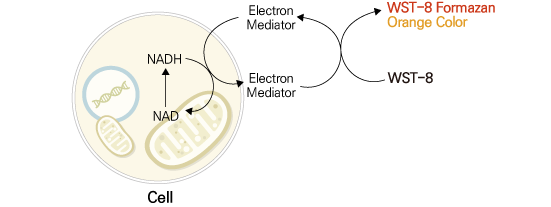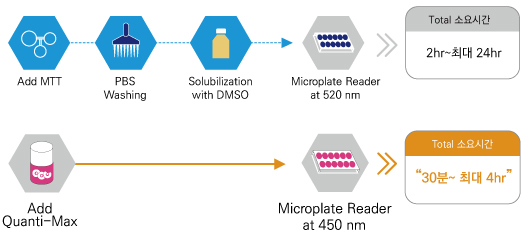WST-8 Cell Counting Kit (QM1000)
- Home
- Life Science
- WST-8 Cell Counting Kit (QM1000)
상품 정보
상품 상세설명
Description
WST-8 Cell Counting Kit measures the amount of living cells using WST-8 and can be used for Cell Viability, Proliferation & Cytotoxicity Assay. The key component, WST-8, is a highly water-soluble Tetrazolium Salt that reacts with dehydrogenase in living cells to form an orange-colored, water-soluble formazan product. Dehydrogenase is an enzyme that exists in the mitochondrial electron transport chain of metabolically active cells and is active only in living cells.
Thus, the production of formazan is linearly correlated with the number of living cells, which can be determined by measuring the absorbance (450nm). WST-8 Cell Counting Kit is a sterilized single bottle solution that can be used without preparation beforehand, eliminating the process of melting formazan and the need to remove culture media, allowing the user to easily test the suspension cell.
It is refrigerated in 0~4℃ and can be used without change of activity for 1 year from the date of manufacture. It can be used for more than 2 years when stored at -20℃. However, when the product is frozen and thawed repeatedly, the activity may reduce and the background may increase. Because this product is sensitive to light, store in a container that blocks light or in a container covered with aluminum foil.

Kit contents
Cat. No. |
Components | Size | Storage |
|---|---|---|---|
QM1000 |
1000 tests |
5 ㎖ x 2 Bottles |
4 ℃ |
| QM2500 | 2500 tests | 5 ㎖ x 5 Bottles | |
| QM5000 | 5000 tests | 25 ㎖ x 2 Bottles | |
| QM10000 | 10000 tests | 25 ㎖ x 4 Bottles |
Assay procedure compared with MTT

Sensitivity & Stability

Ciatation
1) Choi, B., Kim, J.E., Park, S.O., Kim, E.Y., Oh, S., Choi, H., Yoon, D., Min, H.J., Kim, H.R., and Chang, E.J. (2022). Sphingosine-1-phosphate hinders the osteogenic differentiation of dental pulp stem cells in association with AKT signaling pathways. Int J Oral Sci 14, 21. 10.1038/s41368-022-00173-5.
2) Chung, C.H., Jung, W., Keum, H., Kim, T.W., and Jon, S. (2020). Nanoparticles Derived from the Natural Antioxidant Rosmarinic Acid Ameliorate Acute Inflammatory Bowel Disease. ACS Nano 14, 6887-6896. 10.1021/acsnano.0c01018.
3) Kwon, K., Cho, H., Lee, S., Cho, E.J., Yu, W., Kok, C.Y.L., Je, H.S., Kim, J.-I., Cho, H.J., and Kwon, T. (2022). Adaptive cellular response of the substantia nigra dopaminergic neurons upon age-dependent iron accumulation. Aging Cell 21, e13694. https://doi.org/10.1111/acel.13694.
4) Hwang, C., Choi, M.-H., Kim, H.-E., Jeong, S.-H., and Park, J.-U. (2022). Reactive oxygen species-generating hydrogel platform for enhanced antibacterial therapy. NPG Asia Materials 14, 72. 10.1038/s41427-022-00420-5.
5) Jang, M., Oh, S.W., Lee, Y., Kim, J.Y., Ji, E.S., and Kim, P. (2022). Targeting extracellular matrix glycation to attenuate fibroblast activation. Acta Biomaterialia 141, 255-263. https://doi.org/10.1016/j.actbio.2022.01.040.
6) Keum, H., Kim, D., Kim, J., Kim, T.W., Whang, C.-H., Jung, W., and Jon, S. (2021). A bilirubin-derived nanomedicine attenuates the pathological cascade of pulmonary fibrosis. Biomaterials 275, 120986. https://doi.org/10.1016/j.biomaterials.2021.120986.
7) Kim, T.Y., Kim, J.-Y., Kwon, H.C., Jeon, S., Lee, S.j., Jung, H., Kim, S., Jang, D.S., and Lee, C.J. (2022). Astersaponin I from Aster koraiensis is a natural viral fusion blocker that inhibits the infection of SARS-CoV-2 variants and syncytium formation. Antiviral Research 208, 105428. https://doi.org/10.1016/j.antiviral.2022.105428.
8) Kang, J.-Y., Kim, H., Mun, D., Yun, N., and Joung, B. (2021). Co-delivery of curcumin and miRNA-144-3p using heart-targeted extracellular vesicles enhances the therapeutic efficacy for myocardial infarction. Journal of Controlled Release 331, 62-73. https://doi.org/10.1016/j.jconrel.2021.01.018.



